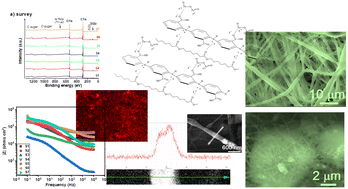Iron oxide – poly(m-anthranilic acid)–poly(ε-caprolactone) electrospun composite nanofibers: fabrication and properties
Abstract
The inclusion of iron and carboxylic acid-functionalized polyaniline into polymeric polycaprolactone structures is expected to enhance the electron-donating ability which in turn increases the compound conductivity and may induce reversible redox chemistry, allowing them to be used in electrochemical immunosensors. Iron oxide-containing poly(m-anthranilic acid) (P3ANA)–polycaprolactone (PCL) composite nanofibers were electrospun and investigated by structural, morphological, chemical composition, and electrochemical analyses. The findings confirm that blending polymers of different characteristics and ratios improves morphologic homogeneity and electrical (impedimetric) properties. Frequency-dependent electrochemical investigation using electrochemical impedance spectroscopy shows remarkable changes in the percentage of polymer contents, particularly when Fe2O3 and Fe3O4 are present. The modifications in the chemical state of the samples confirmed by the C–O and C![[double bond, length as m-dash]](https://www.rsc.org/images/entities/char_e001.gif) O peaks are analyzed by means of X-ray photoelectron spectroscopy. Hence, this study presents a new composite structure, iron (in two forms) P3ANA/PCL composite nanofibers, and the assessment of their intrinsic properties enabling the discovery of possible application fields in biomedical and sensor applications.
O peaks are analyzed by means of X-ray photoelectron spectroscopy. Hence, this study presents a new composite structure, iron (in two forms) P3ANA/PCL composite nanofibers, and the assessment of their intrinsic properties enabling the discovery of possible application fields in biomedical and sensor applications.



 Please wait while we load your content...
Please wait while we load your content...